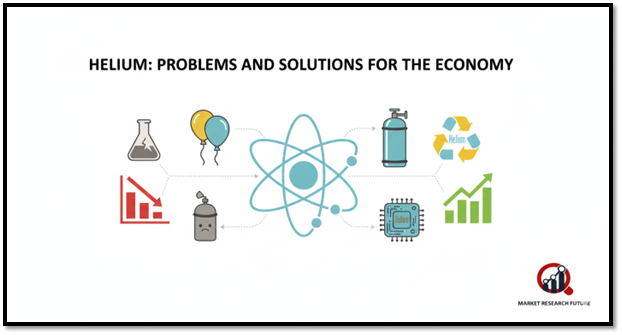Helium: Economic Challenges and Solutions

Information about the Helium Market
Helium is one of the most important and useful elements in science and industry today. Helium is important in medicine, industry, and research because it is light, inert, and has unique cooling properties. It is used in nuclear magnetic resonance (NMR) spectroscopy instruments and magnetic resonance imaging (MRI) machines to keep things cool. It is also used a lot in cryogenics, where very low temperatures are needed. Helium is also very important in fiber optic systems, where it boosts signals, and in other high-tech uses.
A Valuable and Limited Resource
Helium is the second most common element in the universe, but it can't be replaced on Earth. Natural gas wells are where most of the helium on Earth is found. It is usually mixed with other gases like methane, ethane, propane, butane, and pentane. Fractional distillation is a complicated industrial process that separates usable helium from these natural gas liquids. Helium is very valuable for business, especially in science and industry, because it has many specialized uses.
High Demand, Low Supply
The demand for helium around the world is growing because of new technologies and more uses in medicine, research, and industry. Medical diagnostics, especially MRI machines, use the most helium around the world. Research labs, deep-sea exploration, and semiconductor manufacturing also depend on its unique properties.
But there are a lot of problems that come with this growing demand. Helium reserves are limited and mostly found in a few places, like Qatar and other gas-rich countries. It costs a lot to get it out. Environmental issues, resource depletion, and more industrial use are putting more stress on supply chains, which is causing prices to go up. These economic problems show how important it is to find new ways to manage things and keep them going.
New Ideas for a Valuable Resource
Companies are trying out a number of different strategies to get around these limits. Recycling helium in labs and factories cuts down on waste, and new extraction and purification methods get the most out of existing sources. Some efforts are focused on finding new sources, such as specialized industrial processes and new ways to store things.
Innovation is also helping businesses use helium better. Advanced systems in medicine and research cut down on gas losses, and better storage makes transportation safer and cheaper. These solutions not only stabilize the supply of helium, but they also make it easier to use for a wider range of uses.
Chances for Market Leaders
There are a lot of chances in the helium market because of the problems it is having. Companies that put money into sustainable extraction, recycling, and smart use are likely to be the market leaders. To fix future supply-demand imbalances, it will be important to work together strategically, invest in research and development, and come up with new technological solutions. Market leaders who plan for problems and put strategies in place that look ahead can keep their position and help industries that depend on helium.
Looking Ahead: A Market Ready to Grow
Helium is still a very useful resource in 2025, and its uses are growing. Helium in both liquid and solid forms is finding new markets outside of medicine and industry. For example, it is being used in specialty manufacturing and even in recreational products. As industries come up with new ideas and uses, demand is likely to keep going up.
The future of the helium market depends on finding a balance between limited supply and new technology. Helium will continue to meet important industrial, scientific, and medical needs as long as we use it in a way that is environmentally friendly, extract it efficiently, and make the most of it. Market leaders can turn these problems into chances with the right strategies, making sure that helium stays a valuable resource for many years to come.

Leave a Comment